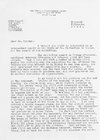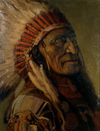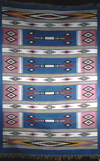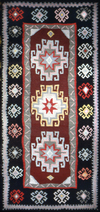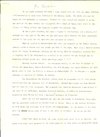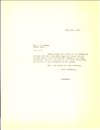“Capable and Intelligent Citizens:” Archives, Art, & Museum
Archives
The first archival document given to the University was donated on 19 October 1909. Much more documentation was to come, all gifts to the University due in part to the work of Edmund Oliver.
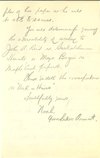
correspondence from Oliver to Murray: “Thus endeth the correspondence re ‘Ark – Hives.’ Faithfully yours, Noah, Goose Lake & Araratt”
In July 1909, prior to his arrival in Saskatoon, Oliver wrote to Murray to advise that he had contacted the "Dominion Archives department" to request they "forward to our library a complete set of their archives. For once the government had anticipated a petition and I was informed that a set had already been sent. I shall be anxious to secure Hansard and other departmental papers so soon as you have room to store them. I have written to ascertain upon what conditions we can secure from England such sets as the Calendar of State Papers, Annual Registers etc. I have found that students must do laboratory work in history as well as in physics and we must secure the equipment necessary as soon as practicable." Within two years of his arrival, Oliver had met and discussed the opportunity of establishing the University's resources for research with Legislative Librarian John Hawkes, Premier Walter Scott, and Dominion Archivist Arthur Doughty, as well as numerous families throughout the province, from whom he acquired varied and interesting documents and artifacts.  In this, he had the active support of Walter Murray, who used his own networks in helping to obtain materials ("You know the importance and the value of these historical records better than anyone else. Would you use your good offices in securing them for the University?"), convinced donors that the institution was an appropriate and safe repository ("You may rest assured that anything that you may entrust to the University in this way will be carefully guarded, and that this is one of the surest ways of having these memorials preserved"); and, in thanking a donor, happily acknowledged their progress ("Already we have secured a number of important books and documents by loans and purchase, and we hope to form a valuable collection of historical records").
In this, he had the active support of Walter Murray, who used his own networks in helping to obtain materials ("You know the importance and the value of these historical records better than anyone else. Would you use your good offices in securing them for the University?"), convinced donors that the institution was an appropriate and safe repository ("You may rest assured that anything that you may entrust to the University in this way will be carefully guarded, and that this is one of the surest ways of having these memorials preserved"); and, in thanking a donor, happily acknowledged their progress ("Already we have secured a number of important books and documents by loans and purchase, and we hope to form a valuable collection of historical records").
“As I understand my work," Oliver wrote, “while it should be as scholarly as possible, it should produce not trained historians, but capable and intelligent citizens. As soon as we secure adequate equipment, I have hopes that our students may be able to contribute something to the intelligent discussion of public questions. In part this will be a new field even for myself but I am convinced that in this direction lies a great opportunity." Both Murray and Oliver would have had prior experience of, and appreciation for, archival collections. They certainly would have considered the development of such a collection as useful and even necessary to the development of the University. More importantly, as it turned out, was Murray's concept of the role of the University within the wider community it served. Early in 1911, Murray wrote Premier Scott:
Dr. Oliver was talking over with me his conversation with you about the preservation of publications relating to the history of the province .... His list included, files of newspapers; directories, city and telephone; reports of Boards of Trade; civic and provincial publications; Dominion reports relating to the province; pamphlets and books relating to local history; reports of religious bodies, i.e. diocesan, conference, synod etc., YM.C.A. and Sunday School reports; reports of social organizations such as musical societies, reform associations, athletic societies and boy scouts' reports; settlement surveys, documents relating to settlement of the country, immigration reports, etc.; reports of law and order, as the R.N.W.M.P.; and railway reports.
The Legislative Library should undoubtedly have a complete set, and the University Library should form a collection as complete as possible ...
Would it not be wise for the Government to appoint a commission to go into the question of the preservation of historical documents, or rather for the collection of provincial archives? This commission would, of course, be a purely advisory body .... The commission might consist of the Premier and any other member of the Government specially interested in the matter, two of the members of the Legislature, a professor of History from the University, the President of the University and the Provincial Librarian. I think it would be most serviceable to have the opinions of such a committee if you were contemplating the expenditure of any large amount of money for such a collection as indicated .....
It is unnecessary to remind you of the great importance of beginning now to make such a collection. We have found it practically impossible to secure a complete set of the reports of the Mounted Police. The early ones were nearly all destroyed by fire a few years ago. Many newspaper files are at present incomplete, and the difficulty of completing them will increase as the time goes by. We have found it impossible to secure a complete set of the Provincial Gazette from September 1905.
This letter is remarkable in many ways. It clearly demonstrates how inclusive an approach they envisioned, with acquisitions intended to document all aspects of provincial and community life, from athletics to law, church and state, 'reform' associations to business. It indicates the urgency of the issue, and proposes a unique solution, including a tripartite body consisting, in diminishing numbers, of the government, the University, and the provincial library. Murray's consideration of the importance of his committee is evident in the members he specifically included: the Premier, the University's president, and the Provincial Librarian: no delegation of authority here. It was the first proposal for a provincial archives, inferred that such an institution required a broad mandate and provided a role for institutions other than the government in its establishment.
Scott's reply, unfortunately, vaguely suggested the government's intent of "making a substantial vote ... for Library purposes" and noted the advisability of appointing "a small and carefully selected commission to deal with such matters as the purchase of paintings and objects of art for the new Provincial building." In neither instance did he appear to have fully appreciated the matter at hand, nor the innovative approach Murray proposed.
Art
A quick review of the art known to have been acquired by the University during Murray’s tenure reveals several interesting features. The collection contains prominent and emerging artists from the time, as well as talented ‘amateurs.’ Murray was not afraid to trust either his own tastes or those of Regina lawyer and avid art collector, Norman MacKenzie, and so the University became a collector of several artists quite early in their careers, who later went on to great fame. Despite an apparent reliance on Murray and MacKenzie’s judgement, the early collection is notable for its diversity of styles, subjects and media. Note, for example, a small sample of works acquired in 1925:
To their credit, both men valued the work of Saskatchewan artists. On 15 February 1924, Mackenzie wrote "My hope always has been to see Saskatchewan purchasing from our local artists....When you think that in this province we have men like [Gus] Kenderdine, [James] Henderson, [David] Payne, [Inglis] Sheldon-Williams, it seems astonishing. The works of these, along their own lines, could hang in any gallery in New York." Eleven days later he repeated this theme in another letter: "I think we should patronize Saskatchewan when we have artists here the equal of any in Canada, and I am glad to see that the feeling throughout the Province is to respect the artist, irrespective of his locality."
A substantial portion of the acquisitions could be termed “documentary art” – notably portraits, which constitute just over one-third of the University’s art collection during Murray’s tenure. Most importantly, a series of portraits of prominent chiefs from Saskatchewan and Alberta were purchased – and many specifically commissioned. Murray received Board approval to commission “a dozen studies of Indians for a total cost of $3,000.00” and a travel advance of “up to $400 or $500 and if necessary more” for James Henderson; [Page 1] and during the Depression, Nicholas de Grandmaison was able to sell numerous portraits to the University. “These dark days of depression have been very trying on all of us but I had my especial bad share of it,” Grandmaison wrote in 1933; three years later he wrote to Murray “I write to you now with the same hope of understanding with which you always in past were dealing with me and for what I always felt gratitude to you.” Having just made a sale to the Canadian Pacific Railway (CPR) of one of his native portraits – used by the railway in advertisements – Grandmaison notes, “This reproduction made my name across the country and I hope you like to know this fact as after all you were one of first my patrons.”
Similarly interesting was the early acquisition by the University of woven rugs – Doukhobor or Ukrainian in origin.
Likely acquired as early as 1925, these may be a reflection of Murray’s longstanding interest in immigration and the valuable contributions of various ethnic groups to the province; but they are certainly a reflection of his catholic appreciation of artistic skill.
Murray clearly appreciated art; and he valued it as a University resource. A tribute to Gus Kenderdine clearly demonstrates Murray’s appreciation both for art, and artists.
The majority of acquisitions during his tenure were not gifts to the institution, but purchases and often, commissioned works. Moreover, he and Christina donated works from their personal collection.
Museum
Walter Murray’s first President’s Report in 1908-09 mentioned an official museum for the University; and, before the first student enrolled, the University was collecting artifacts.
Additionally, as noted in the first calendars, the College of Agriculture and its departments anticipated museums “for demonstration purposes.” The College museum consisted of “plants, insects, birds, furbearing and other animals peculiar to Saskatchewan.” Of the departmental museums, it was anticipated that “the animal husbandry and veterinary science department will have skeletons...and specimens of feed stuffs of various kinds. The field husbandry department will have specimens of various kinds of plants adapted to the needs of the West, seeds, grains, grasses, clovers, roots and vegetables. The department of agricultural engineering will gather implements and devices of various kinds that have been used in tilling the soil, preparing seed, and doing other kinds of work upon the farms of the prairies.” Donations were eagerly sought: “Anyone possessing anything of interest to these departments can add to their usefulness by contributing such articles to the College museum.”
Arthur S. Morton, Professor of History was an early advocate for a University Museum. In 1917 he organized the Museum Committee of the University Historical Association which was to take charge of collecting ‘curios’ for a folk museum on campus. Their goal was to preserve “the memory of the customs and art of the people from non-English speaking lands who have made Canada their home”.
This collection’s first home was the attic of the Physics Building. Opening in 1922, the space was cramped and was “very dirty owing to the dust storms”. It opened just once a year for an annual tea. In 1936 the museum was moved to the tower of Qu’Appelle Hall to make room for Professor Herzberg’s laboratory. The space was very small with many of the artifacts stored in an unused washroom. When President Murray retired in 1937, the museum collection was moved to the Little Stone School House where it was subject to vandalism and theft. The collection made its last move in 1946 to the attic of the College Building where it was destroyed by fire in October of 1947.
A formal, central university museum was part of Murray’s plan for the institution. The closest it came to reality was in the late 1920s when a museum space was part of the plans for a new Arts and Science building to be called Haultain Hall. For a variety of reasons the building was never constructed.
Related Items
- Office of the President fonds
- Walter Murray




